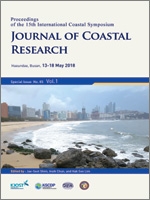Muthusankar, G.; Proisy, C.; Balasubramanian, D.; Bautès, N.; Bhalla, R S.; Mathevet, R.; Ricout, A.; Senthil Babu, D., and Vasudevan, S., 2018. When socio-economic plans exacerbate vulnerability to physical coastal processes on the south east coast of India. In: Shim, J.-S.; Chun, I., and Lim, H.S. (eds.), Proceedings from the International Coastal Symposium (ICS) 2018 (Busan, Republic of Korea). Journal of Coastal Research, Special Issue No. 85, pp. 1446–1450. Coconut Creek (Florida), ISSN 0749-0208.
Industrial and urban development along the coast may exacerbate the changes induced by oceano-climatic processes to such an extent that the coast becomes uninhabitable. This paper presents a baseline study carried out on the 360 km-long Coromandel coast of Tamil Nadu's (TN) Bay of Bengal coast, Southeast India. About 30% of the 72 million inhabitants of the state of TN live in low-lying coastal areas within a variety of ecosystems such as sandy beaches and dunes, wetlands, mudflats and mangroves. Exponential demographic growth combines with dense urban agglomerations, ever-growing industrial and harbour areas, aquaculture and luxury tourism expansion increasing vulnerabilities to coastal erosion and extreme meteorological events. We report here how very high spatial resolution satellite (VHSRS) images, freely provided by Google Earth® engine or from the public database offered by GIS software, may be used to impartially and significantly survey coastal land cover (LC) transformations at fine scales over a number of years using preliminary visual interpretation. The study also gathered demographic data, historical records on strength and trajectories of the cyclones that have hit the TN coast since 1900, and decadal series of daily ERA-Interim/ECMWF waves and Mercator-Ocean oceanic currents. Our results demonstrate a tangle of environmental and human activities and situations subject to specific coastal hazards, particularly severe during the Northeast monsoon season. The potential risks for coastal ecosystems and local communities are finally discussed.





